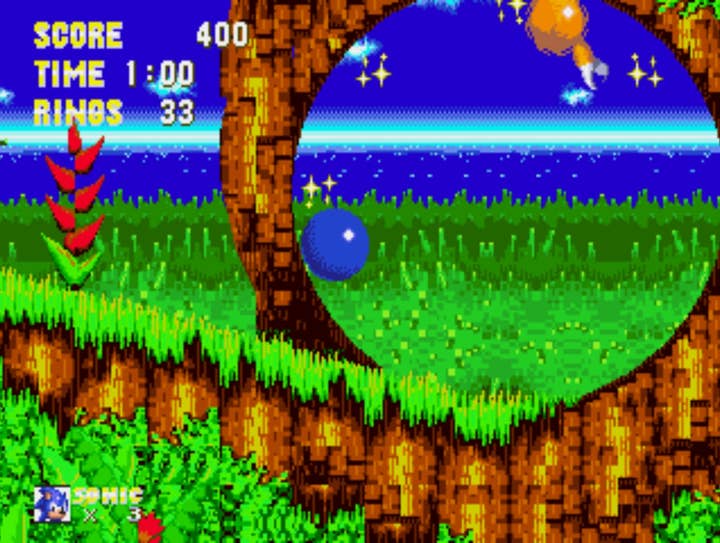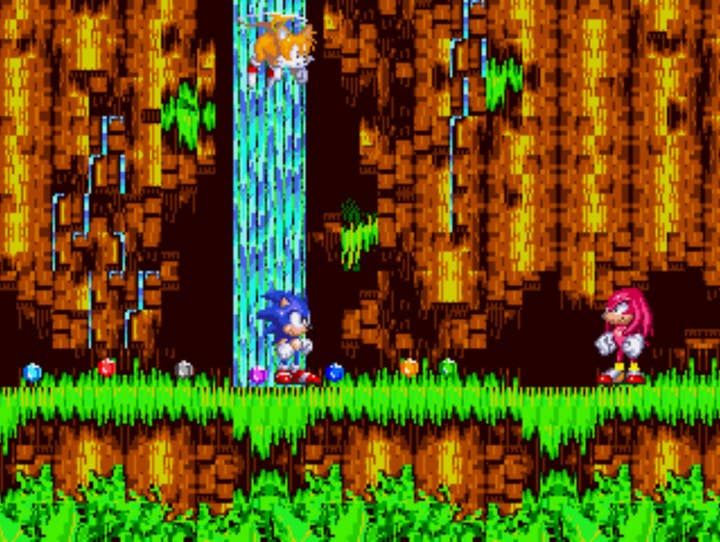Sonic 3 makes a fine holiday tradition | Why I Love
'Tis the season for Thunderful Development programmer Katharina Wunder to revisit Sega's 16-bit classic
Why I Love is a series of guest editorials on GamesIndustry.biz intended to showcase the ways in which game developers appreciate each other's work. This entry was contributed by Katharina Wunder, Programmer at Thunderful Development, who will be launching the story-driven action-adventure Wavetale this December on PC, Xbox, PlayStation and Switch.
We all have our own Christmas traditions and, as we approach the holidays, it's time for me to start preparing for mine. It's time to dig through the cupboards, pull out my old Sega Mega Drive and return to my beloved Sonic series.
The very first video game I ever encountered in my life was Sonic 3. I was about five years old when I started spending my afternoons at a youth centre in our little town in the East-German countryside. Here, kids could hang out after school, buy a glass of Sprite for 50 German pfennig and get help with their homework. Despite a range of other interesting activities offered, the agreed-upon highlight of the place was an old TV set in the corner of the room. The local church blessed us by donating a Sega Mega Drive and it came with Sonic 3.
At all times there was a flock of kids playing, discussing strategies, and passing controllers back and forth for different levels and bonus stages. At this point, please imagine a room of elementary school kids panicking to the sound of Sonic drowning while desperately trying to hunt for air bubbles in the Hydrocity Zone. It was a great group effort. And there was me in the back row, soaking up all the impressions, wondering if I could also give it a try and eventually become as skilled as the older kids.

Somehow, they always seemed to know exactly where to go and every jump appeared to be the perfect continuation in a gymnastic sequence towards the end of the stage. Everything looked so effortless and elegant.
When I later got the chance to give it a try, I realised it was not (only) the amazing gaming skills of those older kids that was smooth and seamless but the actual game itself. What I encountered was an incredible feeling of flow.
The threshold to get started in Sonic 3 is low: a short cutscene and one gets right into the action. No tutorial is needed – the game's rules are intuitive enough to understand within seconds. As I navigated through the lush worlds, I started spinning and rolling onwards. Before I knew it, I seemed to lose control of the game as Sonic shot forward. The blue hedgehog rushed through various pipes and loops while the camera seemingly had a hard time keeping up at all.
Eventually, I stopped in front of a wall, safe and sound, with the feeling of having just gotten off a roller coaster. It was rapid controlled chaos and it was genius. The sort of design that goes past your brain straight into muscle memory.
During the time, at the height of the 90's console wars, Sega often proclaimed the Mega Drive to have exclusive Blast Processing powers to be able to run such a fast game. Blast Processing is now widely considered a marketing ploy. While it described a real existing technique, it was actually about extending the console's colour palette in certain scenarios and unrelated to processing powers. By no means does it have anything to do with Sonic rushing across your screen so quickly. It does show, however, how incredibly impactful the flow design in the Sonic games was - so much larger than life that it must seemingly require especially powerful hardware to be able to support it.

Other than speed and flow, the intuitiveness of the game always impressed me. When playing Sonic 3, you always seem to find the right way. The game offers various routes to reach the finishing line and rewards exploration with bonus stages and hidden items. Even when accidentally dropping down to a lower floor, it is possible to continue quickly without too much disorientation.
This is particularly remarkable if you consider that Sonic 3 lets the player choose from three different characters who each bring their individual skill to the table. Whether this is spinning, flying, or climbing, every stage has to account for all possible scenarios.
In order to unlock Knuckles, the character with the climbing ability, some extra measures have to be taken. This is because Sonic 3 is actually only the first half of the full game. To be able to extend development time as well as game content, the full title was distributed onto two separate releases. The second half, named Sonic & Knuckles, came with a special cartridge into which the original Sonic 3 game could be inserted. This would combine the two games and unlock the complete experience.
Sonic & Knuckles itself is another exciting rabbit hole to fall into. From accessing blue sphere bonus stages by inserting various Sega titles to stacking infinitely many of the games' cartridges on top of each other to build a tower - I simply love how much there is to discover with regard to content and hardware when it comes to these titles.

Another aspect of Sonic 3 that I deeply care about is the fact that it is a couch co-op game. This is solved in a slightly unusual way though, where the second player, taking over the role of Tails, cannot die or progress the game by themselves. In the meantime, player one as Sonic has the option to completely disregard player two and move on without them. It is therefore often known as the game to shut up that annoying younger sibling of yours, who constantly asks about when it is their turn to finally also play: Just hand them the second controller, run off with Sonic and ignore as they desperately try to catch up. Here, I personally find the multiplayer story mode to be a bit underrated because you rarely hear about people actually cooperating (or maybe I had an over-proportional number of uncollaborative siblings in my environment - that might be true as well).
In order to play well together, the two players have to communicate to find routes and a good rhythm to not lose each other. Tails has the ability to carry Sonic for a few seconds, which comes in handy to reach hidden places. When two players communicate well, they can develop a great level of sync. The Sonic player might just start to silently jump off ledges into the void, expecting the Tails player to catch and carry them onwards. It is a great cooperative multiplayer experience and one of the nicest bonding memories I have with my sister, who is my Sonic partner in crime.
I cannot talk about Sonic 3 without mentioning the incredible soundtrack of the game. Many evenings were spent with the controller in my hand, singing along made-up lyrics to the individual stage tunes. It is my personal goal in every play session to reach at least the Ice Cap Zone in order to be rewarded with what is undoubtedly the best song of the game. The making of the soundtrack is full of interesting little facts and stories, too. For a long time, it was widely speculated that Michael Jackson and his team worked on the music of Sonic 3 at some point. This originally started as a fan rumour but has since been officially confirmed by Sonic creator Yuji Naka over Twitter.
Only this year, I found out that the background music of my favourite stage, Ice Cap Zone, is actually the base of an unreleased song by The Jetzons with the title Hard Times, composed by Jackson's keyboardist Brad Buxer. There are even lyrics that I did not have to make up myself - what is not to love about this? Even after so many years, this game keeps on giving and the trivia is endless.

Now, some 25 years later, I am a developer myself and so is that sister who loves Sonic just as much as me. My team at Thunderful Development and I just finished work on a game that also focuses on flowy mechanics. In Wavetale, our protagonist Sigrid is able to surf the waves with the help of a mysterious ocean spirit. Like Sonic 3, Wavetale aims for intuitive and seamless movement.
During the creation of Wavetale, I started looking at the Sonic series with a new set of eyes and came to the (obvious but at the same time not so obvious) conclusion: creating an experience with a good flow is really hard. What exactly feels intuitive and what gives the player this satisfying feeling? Which challenges did the Sonic team have to overcome to make this game where all the movement feels so easy and elegant?
Developing a game with a satisfying flow often means working with something that cannot precisely be measured - the absence of unnatural and distracting interruptions. While there are game design theories on how to approach this, in the end, there is a lot of trial and error involved. There is no one-fits-all solution and the findings of those tests can be rather counterintuitive. When working towards making a more dynamic game feel, for example, developers might be tempted to keep increasing player speed. At times, however, reducing player speed can be the step that actually leads to the gameplay feeling faster and more fluid overall. Like Sonic 3, Wavetale has speedy and slower sections. Those areas call for smooth transitions to keep a coherent pace throughout the game.
Taking different player skills into account makes this task even more complex. Casual players should be able to just pick up and enjoy without too much distraction, while more experienced players should be encouraged to explore and experiment. Our movement team, Designer Regina Rova and Programmer Niklas Lingsell, worked tirelessly on finding the right balance in all these aspects in Wavetale.
"The less the player has to think about a mechanic... the more time and effort the development team most likely put into [it]"
As a player, it is often hard to imagine how a game could be any different from the end result: "Of course, it had to turn out this way, this is just the natural shape of the game." In reality, a rule of thumb that seems to be true for most games: the less the player has to think about a mechanic, like movement or camera behaviour, the more time and effort the development team most likely put into achieving this being the case. Since working on Wavetale, my appreciation for the teams who work on making all those invisible design decisions one does not consciously appreciate in the end, has risen tenfold.
I am unsure whether my appreciation for Sonic 3 is tainted by the fact that it essentially shaped my concept of what a video game is in the first place, but even after so many years I have not gotten bored of it. In my opinion, it is a great game that still holds up very well. There are so many aspects of the game that I have not even touched upon here. It comes from a time period when gaming was nothing short of magical. The amount of trivia surrounding the development of Sonic 3 and Knuckles gives it this extra layer of mystery and one can spend hours upon hours reading various articles online.
At this point, Sonic 3 is available on basically all platforms (though some of those catchy original tunes were replaced in certain releases due to copyright reasons). If you find yourself bored during the winter holidays, I suggest giving Sonic 3 a go. Maybe you have a friend or sibling who would appreciate playing the game with you. Or maybe you were the younger sibling who had to play as Tails as your older brother or sister progressed onwards without you. Maybe it's time to revisit the title as a real co-op experience.
I know I will play it again, at least to the Ice Cap Zone to listen to my favourite Christmas tune.
Developers interested in contributing their own Why I Love column are encouraged to reach out to us at news@gamesindustry.biz.
